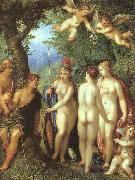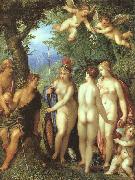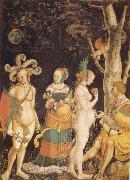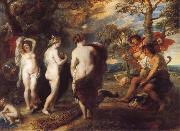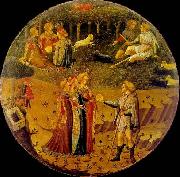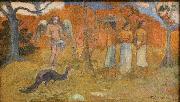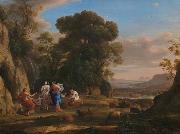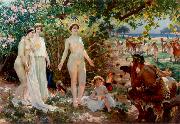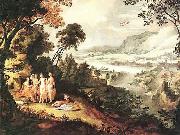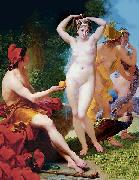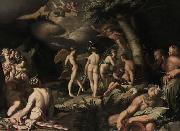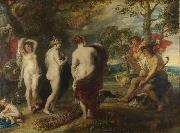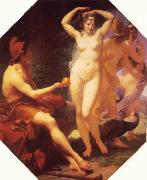Wholesale Oil Painting No Minimum |
|||||||||||
|
|
|||||||||||

|
|||||||||||
|
|
|
||||||||
Balen, Hendrick vonDutch, approx. 1575-1632 Hendrik van Balen Students included Anthony Van Dyck, Frans Snyders and Gerard Seghers |
||||||||
|
|
||||||||
The Judgement of Paris
The Judgement of Paris Painting ID:: 10708 |
1599, Gemäldegalerie at Berlin 1599, Gemäldegalerie at Berlin |
|||||||
|
|
||||||||
Peter Paul RubensFlemish Baroque Era Painter, 1577-1640 Peter Paul Rubens (June 28, 1577 ?C May 30, 1640) was a prolific seventeenth-century Flemish Baroque painter, and a proponent of an exuberant Baroque style that emphasized movement, color, and sensuality. He is well-known for his Counter-Reformation altarpieces, portraits, landscapes, and history paintings of mythological and allegorical subjects. In addition to running a large studio in Antwerp which produced paintings popular with nobility and art collectors throughout Europe, Rubens was a classically-educated humanist scholar, art collector, and diplomat who was knighted by both Philip IV, king of Spain, and Charles I, king of England. Rubens was a prolific artist. His commissioned works were mostly religious subjects, "history" paintings, which included mythological subjects, and hunt scenes. He painted portraits, especially of friends, and self-portraits, and in later life painted several landscapes. Rubens designed tapestries and prints, as well as his own house. He also oversaw the ephemeral decorations of the Joyous Entry into Antwerp by the Cardinal-Infante Ferdinand in 1635. His drawings are mostly extremely forceful but not detailed; he also made great use of oil sketches as preparatory studies. He was one of the last major artists to make consistent use of wooden panels as a support medium, even for very large works, but he used canvas as well, especially when the work needed to be sent a long distance. For altarpieces he sometimes painted on slate to reduce reflection problems. His fondness of painting full-figured women gave rise to the terms 'Rubensian' or 'Rubenesque' for plus-sized women. The term 'Rubensiaans' is also commonly used in Dutch to denote such women. |
||||||||
|
|
||||||||
|
|
The Judgement of Paris
The Judgement of Paris Painting ID:: 30155 |
mk64
c.1638-1639
Oil on canvas
199x379cm
Madrid,Museo Nacional del Prado
mk64 c.1638-1639 Oil on canvas 199x379cm Madrid,Museo Nacional del Prado |
||||||
|
|
||||||||
BALEN, Hendrick vanDutch Baroque Era Painter, ca.1575-1632 Hendrik van Balen (1575 - 1632) was a Flemish painter, who was born and died in Antwerp. Van Balen studied art while traveling in Italy. He was the teacher of Anthony Van Dyck and Frans Snyders and was also a contemporary of many of the other famous Flemish artists, such as the Brueghels, Jan and Peter. |
||||||||
|
|
||||||||
|
|
The Judgement of Paris
The Judgement of Paris Painting ID:: 32231 |
1599
Oil on canvas 1599 Oil on canvas |
||||||
|
|
||||||||
MANUEL, NiklausSwiss Northern Renaissance Painter, ca.1484-1530 was a Swiss dramaturg, painter, graphic artist and politician. |
||||||||
|
|
||||||||
|
|
The Judgement of Paris
The Judgement of Paris Painting ID:: 33530 |
mk86
c.1517/18
Tempera on canvas
223x160cm
Basle mk86 c.1517/18 Tempera on canvas 223x160cm Basle |
||||||
|
|
||||||||
Joachim Wtewael1566-1638 Flemish Joachim Wtewael Galleries Dutch painter and draughtsman. He was one of the last exponents of MANNERISM. From c. 1590 until 1628, the year of his latest known dated paintings, he employed such typical Mannerist formal devices as brilliant decorative colour, contrived spatial design and contorted poses. He sometimes combined such artifice with naturalism, and this amalgam represents the two approaches Dutch 16th- and 17th-century theorists discussed as uyt den geest (from the imagination) and naer t leven (after life). Wtewaels activity reflects the transition from Mannerism to a more naturalistic style in Dutch art. Slightly over 100 of his paintings and about 80 drawings are known. Subjects from the Bible and mythology predominate; he also painted several portraits, including a Self-portrait (1601; Utrecht, Cent. Mus.). |
||||||||
|
|
||||||||
|
|
The Judgement of Paris
The Judgement of Paris Painting ID:: 43077 |
mk170
1615
Oil on oak
59.8x79.2cm
mk170 1615 Oil on oak 59.8x79.2cm |
||||||
|
|
||||||||
Peter Paul RubensFlemish Baroque Era Painter, 1577-1640 Peter Paul Rubens (June 28, 1577 ?C May 30, 1640) was a prolific seventeenth-century Flemish Baroque painter, and a proponent of an exuberant Baroque style that emphasized movement, color, and sensuality. He is well-known for his Counter-Reformation altarpieces, portraits, landscapes, and history paintings of mythological and allegorical subjects. In addition to running a large studio in Antwerp which produced paintings popular with nobility and art collectors throughout Europe, Rubens was a classically-educated humanist scholar, art collector, and diplomat who was knighted by both Philip IV, king of Spain, and Charles I, king of England. Rubens was a prolific artist. His commissioned works were mostly religious subjects, "history" paintings, which included mythological subjects, and hunt scenes. He painted portraits, especially of friends, and self-portraits, and in later life painted several landscapes. Rubens designed tapestries and prints, as well as his own house. He also oversaw the ephemeral decorations of the Joyous Entry into Antwerp by the Cardinal-Infante Ferdinand in 1635. His drawings are mostly extremely forceful but not detailed; he also made great use of oil sketches as preparatory studies. He was one of the last major artists to make consistent use of wooden panels as a support medium, even for very large works, but he used canvas as well, especially when the work needed to be sent a long distance. For altarpieces he sometimes painted on slate to reduce reflection problems. His fondness of painting full-figured women gave rise to the terms 'Rubensian' or 'Rubenesque' for plus-sized women. The term 'Rubensiaans' is also commonly used in Dutch to denote such women. |
||||||||
|
|
||||||||
|
|
The Judgement of Paris
The Judgement of Paris Painting ID:: 43120 |
mk170
1631-1635
Oil on oak
144.8x193.7cm
mk170 1631-1635 Oil on oak 144.8x193.7cm |
||||||
|
|
||||||||
|
|
||||||||
|
|
The Judgement of Paris
The Judgement of Paris Painting ID:: 44445 |
1430-40
Tempera on wood,
diameter 70 cm 1430-40 Tempera on wood, diameter 70 cm |
||||||
|
|
||||||||
Henri-Pierre Picou(27 February 1824 - 17 July 1895) was a French painter born in Nantes.His oeuvre began with portraits and classical historical subject matter but he later moved on to allegorical and mythological themes.He was an academic painter and one of the founders of the Neo-Grec school, along with his close friends Gustave Boulanger, Jean-L??on G??rôme, and Jean-Louis Hamon, also academic painters. All of them studied in the workshops of both Paul Delaroche and later Charles Gleyre. Picou's style was noticeably influenced by Gleyre. While the rest of the group generally painted classical and mythological subjects, Picou also received commissions for large religious frescoes from many churches, including the Église Saint-Roch. His artistic debut was at the Salon in 1847. The next year he was awarded a second-class medal for his painting, Cl??opâtre et Antoine sur le Cydnus. Also known as Cleopatra on the Cydnus, it is commonly regarded as Picou's masterpiece. This showing at the Salon in 1848 was written about by the critic Th??ophile Gautier, who felt that the subject matter was too ambitious, but also said that "As it is, it gives the best hope for the future of the young artist, and ranks among the seven or eight most important paintings of the Salon.In 1875 the painting was exhibited in New York, and afterward found lodgment on the walls of a private art gallery in San Francisco.Picou maintained a large workshop in Paris on the Boulevard de Magenta, which provided him room to work on his expansive frescoes. His popularity continued to rise and he went on to win the Second Prix de Rome in 1853 for his painting, J??sus chassant les vendeurs du Temple (The Moneylenders Chased from the Temple), and another second-class medal for his Salon painting in 1857. From his debut in 1847, he was a regular at the Salon, showing almost every year until his final exhibit in 1893.He has been called the most fashionable painter towards the close of the Second French Empire |
||||||||
|
|
||||||||
|
|
The Judgement of Paris
The Judgement of Paris Painting ID:: 72714 |
Oil on canvas
21.63 X 27.5 in (54.93 X 69.85 cm)
cjr Oil on canvas 21.63 X 27.5 in (54.93 X 69.85 cm) cjr |
||||||
|
|
||||||||
Paul GauguinFrench 1848-1903 Paul Gauguin Art Locations (born June 7, 1848, Paris, France ?? died May 8, 1903, Atuona, Hiva Oa, Marquesas Islands, French Polynesia) French painter, sculptor, and printmaker. He spent his childhood in Lima (his mother was a Peruvian Creole). From c. 1872 to 1883 he was a successful stockbroker in Paris. He met Camille Pissarro about 1875, and he exhibited several times with the Impressionists. Disillusioned with bourgeois materialism, in 1886 he moved to Pont-Aven, Brittany, where he became the central figure of a group of artists known as the Pont-Aven school. Gauguin coined the term Synthetism to describe his style during this period, referring to the synthesis of his paintings formal elements with the idea or emotion they conveyed. Late in October 1888 Gauguin traveled to Arles, in the south of France, to stay with Vincent van Gogh. The style of the two men work from this period has been classified as Post-Impressionist because it shows an individual, personal development of Impressionism use of colour, brushstroke, and nontraditional subject matter. Increasingly focused on rejecting the materialism of contemporary culture in favour of a more spiritual, unfettered lifestyle, in 1891 he moved to Tahiti. His works became open protests against materialism. He was an influential innovator; Fauvism owed much to his use of colour, and he inspired Pablo Picasso and the development of Cubism. |
||||||||
|
|
||||||||
|
|
The Judgement of Paris
The Judgement of Paris Painting ID:: 81042 |
Date 1902(1902)
Medium Oil on canvas
Dimensions 26.5 x 45.5 cm (10.4 x 17.9 in)
cjr Date 1902(1902) Medium Oil on canvas Dimensions 26.5 x 45.5 cm (10.4 x 17.9 in) cjr |
||||||
|
|
||||||||
Claude LorrainFrench 1600-1682 Claude Lorrain Galleries In Rome, not until the mid-17th century were landscapes deemed fit for serious painting. Northern Europeans, such as the Germans Elsheimer and Brill, had made such views pre-eminent in some of their paintings (as well as Da Vinci in his private drawings or Baldassarre Peruzzi in his decorative frescoes of vedute); but not until Annibale Carracci and his pupil Domenichino do we see landscape become the focus of a canvas by a major Italian artist. Even with the latter two, as with Lorrain, the stated themes of the paintings were mythic or religious. Landscape as a subject was distinctly unclassical and secular. The former quality was not consonant with Renaissance art, which boasted its rivalry with the work of the ancients. The second quality had less public patronage in Counter-Reformation Rome, which prized subjects worthy of "high painting," typically religious or mythic scenes. Pure landscape, like pure still-life or genre painting, reflected an aesthetic viewpoint regarded as lacking in moral seriousness. Rome, the theological and philosophical center of 17th century Italian art, was not quite ready for such a break with tradition. In this matter of the importance of landscape, Lorrain was prescient. Living in a pre-Romantic era, he did not depict those uninhabited panoramas that were to be esteemed in later centuries, such as with Salvatore Rosa. He painted a pastoral world of fields and valleys not distant from castles and towns. If the ocean horizon is represented, it is from the setting of a busy port. Perhaps to feed the public need for paintings with noble themes, his pictures include demigods, heroes and saints, even though his abundant drawings and sketchbooks prove that he was more interested in scenography. Lorrain was described as kind to his pupils and hard-working; keenly observant, but an unlettered man until his death. The painter Joachim von Sandrart is an authority for Claude's life (Academia Artis Pictoriae, 1683); Baldinucci, who obtained information from some of Claude's immediate survivors, relates various incidents to a different effect (Notizie dei professoni del disegno). John Constable described Claude Lorrain as "the most perfect landscape painter the world ever saw", and declared that in Claude??s landscape "all is lovely ?C all amiable ?C all is amenity and repose; the calm sunshine of the heart" |
||||||||
|
|
||||||||
|
|
The Judgement of Paris
The Judgement of Paris Painting ID:: 83311 |
1645-1646
Medium Oil on canvas
cyf 1645-1646 Medium Oil on canvas cyf |
||||||
|
|
||||||||
Attilio SimonettiItalian, 1843-1925 |
||||||||
|
|
||||||||
|
|
The Judgement of Paris
The Judgement of Paris Painting ID:: 84831 |
1904(1904)
Medium Oil on canvas
cyf 1904(1904) Medium Oil on canvas cyf |
||||||
|
|
||||||||
Joos de MomperFlemish Baroque Era Painter, 1564-1635 known as Josse de Momper, is one of the most important Flemish landscape painters between Pieter Brueghel the Elder and Peter Paul Rubens. Brueghel's influence is clearly evident in this many of de Momper's paintings. Born in 1564 in Antwerp, Joos de Momper was first apprenticed to his father. In the 1580s, he travelled to Italy to study art. De Momper primarily painted landscapes, the genre for which he was well-regarded during his lifetime. He painted both fantasy landscapes, viewed from a high vantage point and employing a conventional Mannerist color transition of brown in the foreground to blue and finally green in the background, and more realistic landscapes with a lower viewpoint and more natural colors. His wide panoramas also feature groups of figures. Only a small number of the 500 paintings attributed to De Momper are signed, and just one is dated. |
||||||||
|
|
||||||||
|
|
The Judgement of Paris
The Judgement of Paris Painting ID:: 88567 |
Oil on canvas
cjr Oil on canvas cjr |
||||||
|
|
||||||||
Baron Jean-Baptiste RegnaultParis 1754-1829 French painter. His first teacher was the history painter Jean Bardin, who took him to Rome in 1768. Back in Paris in 1772, he transferred to the studio of Nicolas-Bernard Lepicie. In 1776 he won the Prix de Rome with Alexander and Diogenes (Paris, Ecole N. Sup. B.-A.) and returned to Rome, where he was to spend the next four years at the Academie de France in the company of Jacques-Louis David and Jean-Francois-Pierre Peyron. While witnessing at first hand Peyron's development of a manner indebted to Poussin and David's conversion to Caravaggesque realism, Regnault inclined first towards a Late Baroque mode in a Baptism of Christ (untraced; recorded in two sketches and an etching), then, in Perseus Washing his Hands (1779; Louisville, KY, Speed A. Mus.), to the static Neo-classicism of Anton Raphael Mengs. |
||||||||
|
|
||||||||
|
|
The judgement of paris
The judgement of paris Painting ID:: 89554 |
1820(1820)
Medium oil on canvas
cjr 1820(1820) Medium oil on canvas cjr |
||||||
|
|
||||||||
Abraham Bloemaert(1566, Gorinchem - 27 January 1651, Utrecht), was a Dutch painter and printmaker in etching and engraving. He was one of the "Haarlem Mannerists" from about 1585, but in the new century altered his style to fit new Baroque trends. Bloemaert was the son of an architect, who moved his family to Utrecht in 1575, where Abraham was first a pupil of Gerrit Splinter (pupil of Frans Floris) and of Joos de Beer. He then spent three years in Paris, studying under several masters, and on his return to his native country received further training from Hieronymus Francken. In 1591 he went to Amsterdam, and four years later settled finally at Utrecht, where he became dean of the Guild of St. Luke. He excelled more as a colourist than as a draughtsman, was extremely productive, and painted and etched historical and allegorical pictures, landscapes, still-life, animal pictures and flower pieces. In the first decade of the seventeenth-century, Bloemaert began formulating his landscape paintings to include pictoresque ruined cottagges and other pastoral elements. In these works, the religious or mythological figures play a subordinate role. Country life was to remain Bloemaert's favourite subject, which he depicted with increasing naturalism. He drew motifs such as peasant cottages, dovecotes and trees from life and then on his return to the studio, worked them up into complex imaginary scenes. Among his pupils are his four sons, Hendrick, Frederick, Cornelis, and Adriaan (all of whom achieved considerable reputation as painters or engravers), the two Honthorsts, Ferdinand Bol and Jacob Gerritsz Cuyp. |
||||||||
|
|
||||||||
|
|
The Judgement of Paris
The Judgement of Paris Painting ID:: 90820 |
?
Medium oil on canvas
Dimensions 28¾ x 39 in. (73 x 99 cm.)
cyf ? Medium oil on canvas Dimensions 28¾ x 39 in. (73 x 99 cm.) cyf |
||||||
|
|
||||||||
Peter Paul RubensFlemish Baroque Era Painter, 1577-1640 Peter Paul Rubens (June 28, 1577 ?C May 30, 1640) was a prolific seventeenth-century Flemish Baroque painter, and a proponent of an exuberant Baroque style that emphasized movement, color, and sensuality. He is well-known for his Counter-Reformation altarpieces, portraits, landscapes, and history paintings of mythological and allegorical subjects. In addition to running a large studio in Antwerp which produced paintings popular with nobility and art collectors throughout Europe, Rubens was a classically-educated humanist scholar, art collector, and diplomat who was knighted by both Philip IV, king of Spain, and Charles I, king of England. Rubens was a prolific artist. His commissioned works were mostly religious subjects, "history" paintings, which included mythological subjects, and hunt scenes. He painted portraits, especially of friends, and self-portraits, and in later life painted several landscapes. Rubens designed tapestries and prints, as well as his own house. He also oversaw the ephemeral decorations of the Joyous Entry into Antwerp by the Cardinal-Infante Ferdinand in 1635. His drawings are mostly extremely forceful but not detailed; he also made great use of oil sketches as preparatory studies. He was one of the last major artists to make consistent use of wooden panels as a support medium, even for very large works, but he used canvas as well, especially when the work needed to be sent a long distance. For altarpieces he sometimes painted on slate to reduce reflection problems. His fondness of painting full-figured women gave rise to the terms 'Rubensian' or 'Rubenesque' for plus-sized women. The term 'Rubensiaans' is also commonly used in Dutch to denote such women. |
||||||||
|
|
||||||||
|
|
The Judgement of Paris
The Judgement of Paris Painting ID:: 92077 |
oil on oak
Dimensions Height: 144.8 cm (57 in). Width: 193.7 cm (76.3 in).
cyf oil on oak Dimensions Height: 144.8 cm (57 in). Width: 193.7 cm (76.3 in). cyf |
||||||
|
|
||||||||
Henri RegnaultParis 1843 - Buzenval 1871. French Academic Painter, 1843-1871. Studied under Alexandre Cabanel. Specializes in Orientalism. Painter, son of Victor Regnault. He showed exceptional abilities as a draughtsman from an early age. After a traditional classical education he was sent in 1860 to the Ecole des Beaux-Arts, Paris, where he studied with Louis Lamothe (1822-69) and Alexandre Cabanel. In 1866 he won the Prix de Rome competition with Thetis Giving the Weapons of Vulcan to Achilles (Paris, Ecole N. Sup. B.-A.). In Italy he began several other ambitious history paintings, including Automedon Taming the Horses of Achilles |
||||||||
|
|
||||||||
|
|
The judgement of Paris
The judgement of Paris Painting ID:: 95505 |
1820(1820)
Medium oil on canvas
Dimensions ? x cm
cyf 1820(1820) Medium oil on canvas Dimensions ? x cm cyf |
||||||
|
|
||||||||
|
Henri Regnault Paris 1843 - Buzenval 1871. French Academic Painter, 1843-1871. Studied under Alexandre Cabanel. Specializes in Orientalism. Painter, son of Victor Regnault. He showed exceptional abilities as a draughtsman from an early age. After a traditional classical education he was sent in 1860 to the Ecole des Beaux-Arts, Paris, where he studied with Louis Lamothe (1822-69) and Alexandre Cabanel. In 1866 he won the Prix de Rome competition with Thetis Giving the Weapons of Vulcan to Achilles (Paris, Ecole N. Sup. B.-A.). In Italy he began several other ambitious history paintings, including Automedon Taming the Horses of Achilles The judgement of Paris 1820(1820) Medium oil on canvas Dimensions ? x cm cyf |
||||||||
|
|
||||||||
|
Prev Next
|
||||||||
|
|
||||||||
|
Related Paintings to Henri Regnault :. |
||||||||
|
|
||||||||
|
CONTACT US |
